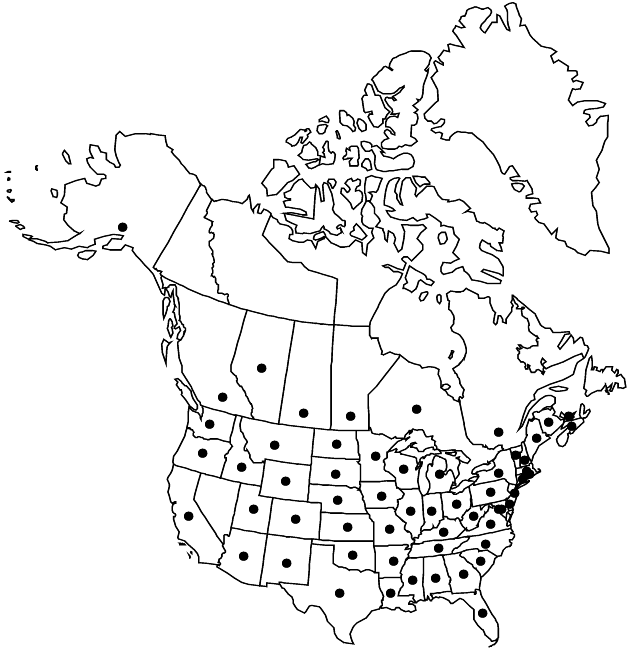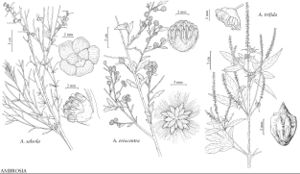Difference between revisions of "Ambrosia trifida"
Sp. Pl. 2: 987. 1753.
FNA>Volume Importer |
imported>Volume Importer |
||
| (6 intermediate revisions by 2 users not shown) | |||
| Line 8: | Line 8: | ||
}} | }} | ||
|common_names=Giant ragweed;grande herbe à poux | |common_names=Giant ragweed;grande herbe à poux | ||
| + | |special_status={{Treatment/ID/Special_status | ||
| + | |code=F | ||
| + | |label=Illustrated | ||
| + | }} | ||
|basionyms= | |basionyms= | ||
|synonyms={{Treatment/ID/Synonym | |synonyms={{Treatment/ID/Synonym | ||
|name=Ambrosia aptera | |name=Ambrosia aptera | ||
|authority=de Candolle | |authority=de Candolle | ||
| − | }}{{Treatment/ID/Synonym | + | |rank=species |
| + | }} {{Treatment/ID/Synonym | ||
|name=Ambrosia trifida var. integrifolia | |name=Ambrosia trifida var. integrifolia | ||
|authority=(Muhlenberg ex Willdenow) Torrey & A. Gray | |authority=(Muhlenberg ex Willdenow) Torrey & A. Gray | ||
| − | }}{{Treatment/ID/Synonym | + | |rank=variety |
| + | }} {{Treatment/ID/Synonym | ||
|name=Ambrosia trifida var. texana | |name=Ambrosia trifida var. texana | ||
|authority=Scheele | |authority=Scheele | ||
| + | |rank=variety | ||
}} | }} | ||
|hierarchy=Asteraceae;Asteraceae tribe Heliantheae;Asteraceae (tribe Heliantheae) subtribe Ambrosiinae;Ambrosia;Ambrosia trifida | |hierarchy=Asteraceae;Asteraceae tribe Heliantheae;Asteraceae (tribe Heliantheae) subtribe Ambrosiinae;Ambrosia;Ambrosia trifida | ||
| Line 33: | Line 40: | ||
|elevation=0–1600 m | |elevation=0–1600 m | ||
|distribution=Alta.;B.C.;Man.;N.B.;N.S.;Ont.;P.E.I.;Que.;Sask.;Ala.;Alaska;Ariz.;Ark.;Calif.;Colo.;Conn.;Del.;D.C.;Fla.;Ga.;Idaho;Ill.;Ind.;Iowa;Kans.;Ky.;La.;Maine;Md.;Mass.;Mich.;Minn.;Miss.;Mo.;Mont.;Nebr.;N.H.;N.J.;N.Mex.;N.Y.;N.C.;N.Dak.;Ohio;Okla.;Oreg.;Pa.;R.I.;S.C.;S.Dak.;Tenn.;Tex.;Utah;Vt.;Va.;Wash.;W.Va.;Wis.;Wyo.;Mexico (Chihuahua). | |distribution=Alta.;B.C.;Man.;N.B.;N.S.;Ont.;P.E.I.;Que.;Sask.;Ala.;Alaska;Ariz.;Ark.;Calif.;Colo.;Conn.;Del.;D.C.;Fla.;Ga.;Idaho;Ill.;Ind.;Iowa;Kans.;Ky.;La.;Maine;Md.;Mass.;Mich.;Minn.;Miss.;Mo.;Mont.;Nebr.;N.H.;N.J.;N.Mex.;N.Y.;N.C.;N.Dak.;Ohio;Okla.;Oreg.;Pa.;R.I.;S.C.;S.Dak.;Tenn.;Tex.;Utah;Vt.;Va.;Wash.;W.Va.;Wis.;Wyo.;Mexico (Chihuahua). | ||
| − | |discussion=<p>The name Ambrosia ×helenae Rouleau applies to hybrids between A. artemisiifolia and A. trifida. Hybrids between A. bidentata and A. trifida have been recorded. Ambrosia trifida may be no longer extant in British Columbia.</p> | + | |discussion=<p>The name <i>Ambrosia</i> ×helenae Rouleau applies to hybrids between <i>A. artemisiifolia</i> and <i>A. trifida</i>. Hybrids between <i>A. bidentata</i> and <i>A. trifida</i> have been recorded. <i>Ambrosia trifida</i> may be no longer extant in British Columbia.</p> |
|tables= | |tables= | ||
|references= | |references= | ||
| Line 42: | Line 49: | ||
-->{{#Taxon: | -->{{#Taxon: | ||
name=Ambrosia trifida | name=Ambrosia trifida | ||
| − | |||
|authority=Linnaeus | |authority=Linnaeus | ||
|rank=species | |rank=species | ||
| Line 56: | Line 62: | ||
|publication title=Sp. Pl. | |publication title=Sp. Pl. | ||
|publication year=1753 | |publication year=1753 | ||
| − | |special status= | + | |special status=Illustrated |
| − | |source xml=https:// | + | |source xml=https://bitbucket.org/aafc-mbb/fna-data-curation/src/2e0870ddd59836b60bcf96646a41e87ea5a5943a/coarse_grained_fna_xml/V19-20-21/V21_13.xml |
|tribe=Asteraceae tribe Heliantheae | |tribe=Asteraceae tribe Heliantheae | ||
|subtribe=Asteraceae (tribe Heliantheae) subtribe Ambrosiinae | |subtribe=Asteraceae (tribe Heliantheae) subtribe Ambrosiinae | ||
Latest revision as of 20:09, 5 November 2020
Annuals, 30–150(–400+) cm. Stems erect. Leaves mostly opposite; petioles 10–30(–70+) mm; blades rounded-deltate to ovate or elliptic, 40–150(–250+) × 30–70(–200+) mm, usually some blades palmately 3(–5)-lobed, bases truncate to cuneate (sometimes decurrent onto petioles), margins usually toothed, rarely entire, abaxial and adaxial faces ± scabrellous and gland-dotted. Pistillate heads clustered, proximal to staminates; florets 1. Staminate heads: peduncles 1–3+ mm; involucres ± saucer-shaped, 2–4 mm diam., scabrellous (often with 1–3 black nerves); florets 3–25+. Burs: bodies ± pyramidal, 3–5(–7+) mm, glabrous or glabrate, spines 4–5, ± distal, ± acerose, 0.5–1 mm, tips straight (bases ± decurrent as ribs). 2n = 24, 48.
Phenology: Flowering Jul–Nov.
Habitat: Disturbed sites, waste places, damp soils
Elevation: 0–1600 m
Distribution

Alta., B.C., Man., N.B., N.S., Ont., P.E.I., Que., Sask., Ala., Alaska, Ariz., Ark., Calif., Colo., Conn., Del., D.C., Fla., Ga., Idaho, Ill., Ind., Iowa, Kans., Ky., La., Maine, Md., Mass., Mich., Minn., Miss., Mo., Mont., Nebr., N.H., N.J., N.Mex., N.Y., N.C., N.Dak., Ohio, Okla., Oreg., Pa., R.I., S.C., S.Dak., Tenn., Tex., Utah, Vt., Va., Wash., W.Va., Wis., Wyo., Mexico (Chihuahua).
Discussion
The name Ambrosia ×helenae Rouleau applies to hybrids between A. artemisiifolia and A. trifida. Hybrids between A. bidentata and A. trifida have been recorded. Ambrosia trifida may be no longer extant in British Columbia.
Selected References
None.
